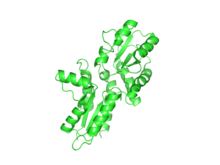- Cobalt chelatase
-
cobalt chelatase [[Image: |220px]] Identifiers EC number 6.6.1.2 CAS number 81295-49-0 Databases IntEnz IntEnz view BRENDA BRENDA entry ExPASy NiceZyme view KEGG KEGG entry MetaCyc metabolic pathway PRIAM profile PDB structures RCSB PDB PDBe PDBsum Gene Ontology AmiGO / EGO Search PMC articles PubMed articles Cobalt chelatase, CobT subunit Identifiers Symbol CobT Pfam PF06213 InterPro IPR006538 Available protein structures: Pfam structures PDB RCSB PDB; PDBe PDBsum structure summary
Cobalt chelatase (EC 6.6.1.2) is an enzyme that catalyzes the chemical reaction- ATP + hydrogenobyrinic acid a,c-diamide + Co2+ + H2O
 ADP + phosphate + cob(II)yrinic acid a,c-diamide + H+
ADP + phosphate + cob(II)yrinic acid a,c-diamide + H+
The 4 substrates of this enzyme are ATP, hydrogenobyrinic acid a,c-diamide, Co2+, and H2O, whereas its 4 products are ADP, phosphate, cob(II)yrinic acid a,c-diamide, and H+.
The aerobic cobalt chelatase (aerobic cobalamin biosynthesis pathway)[2][3] consists of three subunits, CobT, CobN (IPR003672) and CobS (IPR006537).
Cobalamin (vitamin B12) can be complexed with metal via the ATP-dependent reactions (aerobic pathway) (e.g., in Pseudomonas denitrificans) or via ATP-independent reactions (anaerobic pathway) (e.g., in Salmonella typhimurium)[4][5]. The corresponding cobalt chelatases are not homologous. However, aerobic cobalt chelatase subunits CobN and CobS are homologous to Mg-chelatase subunits BchH and BchI, respectively[5]. CobT, too, has been found to be remotely related to the third subunit of Mg-chelatase, BchD (involved in bacteriochlorophyll synthesis, e.g., in Rhodobacter capsulatus)[5].
This enzyme belongs to the family of ligases, specifically those forming nitrogen-D-metal bonds in coordination complexes. The systematic name of this enzyme class is hydrogenobyrinic-acid-a,c-diamide:cobalt cobalt-ligase (ADP-forming). Other names in common use include hydrogenobyrinic acid a,c-diamide cobaltochelatase, CobNST, and CobNCobST. This enzyme participates in porphyrin and chlorophyll metabolism.
References
- ^ Romao CV, Ladakis D, Lobo SAL, Carrondo MA, Brindley AA, Deery E, Matias PM, Pickersgill RW, Saravia LM, Warren MJ. Evolution in a family of chelatases facilitated by the introduction of active site asymmetry and protein oligomerization. (2011) Proc. Natl. Acad. Sci. USA. 108, 97-102. http://www.pnas.org/content/108/1/97.full.pdf+html?sid=d820d5c4-9e1e-459e-ad22-a24df13b0485. Image drawn in PyMOL.
- ^ Crouzet J, Cameron B, Cauchois L, Rigault S, Blanche F, Guilhot C, Levy-schil S, Rouyez MC (1991). "Genetic and sequence analyses of a Pseudomonas denitrificans DNA fragment containing two cob genes". J. Bacteriol. 173 (19): 6058–6065. PMID 1917840.
- ^ Crouzet J, Cameron B, Blanche F, Thibaut D, Debussche L, Couder M (1992). "Assay, purification, and characterization of cobaltochelatase, a unique complex enzyme catalyzing cobalt insertion in hydrogenobyrinic acid a,c-diamide during coenzyme B12 biosynthesis in Pseudomonas denitrificans". J. Bacteriol. 174 (22): 7445–7451. PMC 207441. PMID 1429466. http://www.pubmedcentral.nih.gov/articlerender.fcgi?tool=pmcentrez&artid=207441.
- ^ Roth JR, Lawrence JG, Bobik TA (1996). "Cobalamin (coenzyme B12): synthesis and biological significance". Annu. Rev. Microbiol. 50: 137–181. doi:10.1146/annurev.micro.50.1.137. PMID 8905078.
- ^ a b c Willows RD, Al-Karadaghi S, Hansson M, Fodje MN, Hansson A, Olsen JG, Gough S (2001). "Interplay between an AAA module and an integrin I domain may regulate the function of magnesium chelatase". J. Mol. Biol. 311 (1): 111–122. doi:10.1006/jmbi.2001.4834. PMID 11469861.
Further reading
- Debussche L, Couder M, Thibaut D, Cameron B, Crouzet J, Blanche F (1992). "Assay, purification, and characterization of cobaltochelatase, a unique complex enzyme catalyzing cobalt insertion in hydrogenobyrinic acid a,c-diamide during coenzyme B12 biosynthesis in Pseudomonas denitrificans". J. Bacteriol. 174 (22): 7445–51. PMC 207441. PMID 1429466. http://www.pubmedcentral.nih.gov/articlerender.fcgi?tool=pmcentrez&artid=207441.
- Warren MJ, Raux E, Schubert HL, Escalante-Semerena JC (2002). "The biosynthesis of adenosylcobalamin (vitamin B12)". Nat. Prod. Rep. 19 (4): 390–412. doi:10.1039/b108967f. PMID 12195810.
6.5: Phosphoric Ester 6.6: Nitrogen-Metal B enzm: 1.1/2/3/4/5/6/7/8/10/11/13/14/15-18, 2.1/2/3/4/5/6/7/8, 2.7.10, 2.7.11-12, 3.1/2/3/4/5/6/7, 3.1.3.48, 3.4.21/22/23/24, 4.1/2/3/4/5/6, 5.1/2/3/4/99, 6.1-3/4/5-6 This article includes text from the public domain Pfam and InterPro IPR006538
This ligase article is a stub. You can help Wikipedia by expanding it. - ATP + hydrogenobyrinic acid a,c-diamide + Co2+ + H2O

